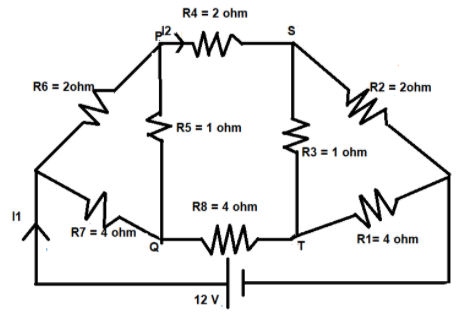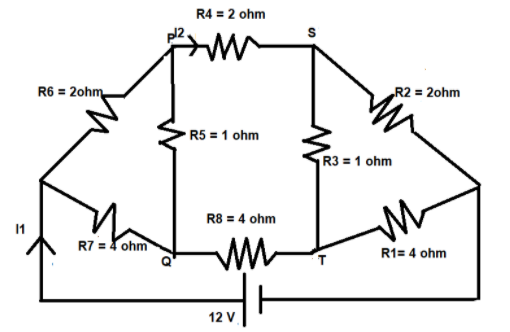
For the resistance network shown in the figure, choose the correct option(s).

A.The current through PQ is zero.
B.\[{{I}_{1}}=3A\]
C.The potential at S is less than that at Q
D.\[{{I}_{2}}=2A\]

Answer
570k+ views
Hint: In series-parallel circuits the Wheatstone bridge condition can be applied to simply the problem. Applying the necessary conditions, we can find the equivalent resistance of the circuit and find the current through each resistance and through the entire circuit.
Complete answer:
The Wheatstone’s bridge condition states that if two or more parallel resistances in equal ratios have a parallel resistor across them, then the current flowing the latter will be zero.
Let us employ this condition in our circuit. We can see that the pair of resistances (R2, R1), (R4, R8) and (R6, R7) are in the ratio 1:2 to each other.
i.e., \[\dfrac{R2}{R1}=\dfrac{R4}{R8}=\dfrac{R6}{R7}=\dfrac{1}{2}\]
Thus, the Wheatstone’s bridge condition is valid here.
This gives in that the resistances R3 and R5 have no role in this circuit. The equivalent circuit will be –

Now, let us calculate the equivalent resistance of the circuit. R2, R4, R6 and R1, R8, R7 are in series with each other.
i.e.,
\[\begin{align}
& \Rightarrow {{R}_{s1}}=R2+R4+R6 \\
& \text{ =2+2+2} \\
& \text{ =6}\Omega \\
& \text{ }and \\
& \text{ }{{R}_{s2}}=R1+R8+R7 \\
& \text{ = 4+4+4} \\
& \text{ =12}\Omega \\
& \dfrac{1}{{{R}_{eq}}}=\dfrac{1}{R}=\dfrac{1}{{{R}_{s1}}}+\dfrac{1}{{{R}_{s2}}} \\
& \Rightarrow \dfrac{1}{R}=\dfrac{12+6}{6\times 12} \\
& \Rightarrow R=4\Omega \\
\end{align}\]
Now, we can find the current through the circuit. The total current ${I_1}$ is given by –\[{I_1}=\dfrac{V}{R}=\dfrac{12}{4}=3A\] --(1)
Current ${I_2}$ is the current passing through the upper hand of the circuit. We can apply the current divider rule to find ${I_2}$.
i.e.,
\[\begin{align}
& \text{ }{I_1}={{I}_{total}}\times \dfrac{{{R}_{2}}}{{{R}_{1}}+{{R}_{2}}} \\
& \Rightarrow {I_2}={I_1}\times \dfrac{{{R}_{s2}}}{{{R}_{s1}}+{{R}_{s2}}} \\
& \Rightarrow {I_2}=3\times \dfrac{12}{6+12} \\
& \text{ =3}\times \dfrac{2}{3} \\
& \therefore {I_2}=2A \\
\end{align}\]
So, we can conclude that –
a) The current ${I_1}$ is 3A.
b) The current ${I_2}$ is 2A.
c) Current doesn’t pass through PQ and ST.
The correct answers are given by options A, B and D.
Note:
We can find the current in the circuit after applying Wheatstone’s condition using the Voltage-divider rule also. We find the voltages across the resistors in series connections and find the current in them. The method we have used is more convenient for this question.
The points P, Q, S and T are equipotential points in the circuit.
Complete answer:
The Wheatstone’s bridge condition states that if two or more parallel resistances in equal ratios have a parallel resistor across them, then the current flowing the latter will be zero.
Let us employ this condition in our circuit. We can see that the pair of resistances (R2, R1), (R4, R8) and (R6, R7) are in the ratio 1:2 to each other.
i.e., \[\dfrac{R2}{R1}=\dfrac{R4}{R8}=\dfrac{R6}{R7}=\dfrac{1}{2}\]
Thus, the Wheatstone’s bridge condition is valid here.
This gives in that the resistances R3 and R5 have no role in this circuit. The equivalent circuit will be –

Now, let us calculate the equivalent resistance of the circuit. R2, R4, R6 and R1, R8, R7 are in series with each other.
i.e.,
\[\begin{align}
& \Rightarrow {{R}_{s1}}=R2+R4+R6 \\
& \text{ =2+2+2} \\
& \text{ =6}\Omega \\
& \text{ }and \\
& \text{ }{{R}_{s2}}=R1+R8+R7 \\
& \text{ = 4+4+4} \\
& \text{ =12}\Omega \\
& \dfrac{1}{{{R}_{eq}}}=\dfrac{1}{R}=\dfrac{1}{{{R}_{s1}}}+\dfrac{1}{{{R}_{s2}}} \\
& \Rightarrow \dfrac{1}{R}=\dfrac{12+6}{6\times 12} \\
& \Rightarrow R=4\Omega \\
\end{align}\]
Now, we can find the current through the circuit. The total current ${I_1}$ is given by –\[{I_1}=\dfrac{V}{R}=\dfrac{12}{4}=3A\] --(1)
Current ${I_2}$ is the current passing through the upper hand of the circuit. We can apply the current divider rule to find ${I_2}$.
i.e.,
\[\begin{align}
& \text{ }{I_1}={{I}_{total}}\times \dfrac{{{R}_{2}}}{{{R}_{1}}+{{R}_{2}}} \\
& \Rightarrow {I_2}={I_1}\times \dfrac{{{R}_{s2}}}{{{R}_{s1}}+{{R}_{s2}}} \\
& \Rightarrow {I_2}=3\times \dfrac{12}{6+12} \\
& \text{ =3}\times \dfrac{2}{3} \\
& \therefore {I_2}=2A \\
\end{align}\]
So, we can conclude that –
a) The current ${I_1}$ is 3A.
b) The current ${I_2}$ is 2A.
c) Current doesn’t pass through PQ and ST.
The correct answers are given by options A, B and D.
Note:
We can find the current in the circuit after applying Wheatstone’s condition using the Voltage-divider rule also. We find the voltages across the resistors in series connections and find the current in them. The method we have used is more convenient for this question.
The points P, Q, S and T are equipotential points in the circuit.
Recently Updated Pages
Master Class 11 Economics: Engaging Questions & Answers for Success

Master Class 11 English: Engaging Questions & Answers for Success

Master Class 11 Social Science: Engaging Questions & Answers for Success

Master Class 11 Biology: Engaging Questions & Answers for Success

Class 11 Question and Answer - Your Ultimate Solutions Guide

Master Class 11 Business Studies: Engaging Questions & Answers for Success

Trending doubts
What is meant by exothermic and endothermic reactions class 11 chemistry CBSE

10 examples of friction in our daily life

One Metric ton is equal to kg A 10000 B 1000 C 100 class 11 physics CBSE

Difference Between Prokaryotic Cells and Eukaryotic Cells

What are Quantum numbers Explain the quantum number class 11 chemistry CBSE

1 Quintal is equal to a 110 kg b 10 kg c 100kg d 1000 class 11 physics CBSE




